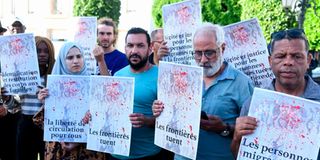Rabat: 2022 city of culture and light holds book fair

Demonstrators lift placards that read in French “borders kill”, as they take part in a rally in the Moroccan capital Rabat on July 1, 2022, demanding an investigation after a massive attempt to storm the barrier between Morocco and Spain’s Melilla enclave on June 24 resulted in the death of 23 migrants.
What you need to know:
- In the session of ‘Pan African Cultural Cooperation’, it was clearly brought out how Kenya is the ‘universal recipient’ of cross-country cultures within its artistic tastes/ tapestry.
- It would be interesting for a Kenyan-now-Norwegian immigrant writer like Ms Philo Ikonya, to pen a similar book, say on her adopted home in Scandinavia, so that we can have a body of work that compares ‘immigrant experiences’ from North Africa to West and East Africa.
- With the ultimate aim, once these ‘white Edens’ are literally fragmented, of turning the African cultural mirror onto ourselves as nationalists, regionalists and Pan Africanists, during these book fairs & festivals.
The item that most made the news from Morocco last month was the death of 23 African migrants, knocking on the doors – or at least trying to vault over the walls – of the northern Maroc town of Nador, in a doomed attempt to break into the Spanish enclave of Melilla, with tragic consequences and worldwide outrage.
Six hours away South-West by road from Nador, in Morocco’s capital of Rabat – that is this year’s UNESCO Cultural Capital of the Islamic World - the Conseil De La Communaute Marocaine a L’Etranger (CCME) had organized the ‘Rabat International Book and Trade Fair,’ under the auspices of its global-minded secretary-general Dr Abdellah Boussouf, who brought together writers and academics from all over the African continent for 11 days in June to discourse in a wide range of panels open to the Moroccan public on the topic of the ‘African continent’s contribution to the Intellectual Diaspora.’
Frederic Ebami, Bellamech Fatimetou, Bencheikh Driss, Rochdi Keltoum, Dieye Mamadou, Tarik Slaiki, Smith Alexandra Jones, Tarabollssi Baha, Kebir Ammi Mustapha, Fall Mar, Elallam Abderrahim and Nguich Marie Noelle were just a tenth of the 120 men-of-letters and women of novels at this continental Book and Trade Fair in Rabat, featuring representation from every corner of the continent – from Tangiers in the north of Morocco to Cape Town in the south of Africa, to Senegal and Nigeria in the West, and Ethiopia and Kenya in the East, the lattermost of which this writer was fortunate to represent.
CCME publishes a book a month, mostly around the topic of migration (and in the light of the tragedy that struck would be African migrants to Spain in Morocco thanks to inflammation by human trafficker cartels seeking to ‘forward human backlog,’ one could say the timing was a tad melancholically ironic), one can see how the topic is central to Morocco – with some of its cities like Tangiers just a few miles from Europe (Spain), and so attractive to illegal immigrants who make a beeline for these fortified borders.
Some of the CCME-published book titles since 2020 are ‘Fragments of the Living Memory of an Immigration and Traveller in Norway’ (Youssef Haji), ‘Migrations Mediterraneennes,’ (El Yazahmi), ‘La realite du passe’ (Ali Benmakhlouf), ‘Migration et droits humains’ (Farid Housni), ‘The Rollin Stones of Africa’ (Reda Bahassou) and ‘Les Filles Qui Sortent: Journeys, sexuality and prostitution in the Maroc’ by Meriam Cheikh.
In 2022, the spotlight is on Rabat as the UNESCO Cultural Capital of the Islamic World, hence the CCME Book and Trade Fair that ran for 11 days and attracted tens of thousands of local denizens of Rabat to it, numbers that would make the organisers of our own Nairobi International Book Fair green with envy.
Cross-country cultures
In the session of ‘Pan African Cultural Cooperation’ moderated by Maroc cultural champion and former Yale professor (and Ambassador of Morocco to Kenya) Mokhtar Ghambou, with Oromo writer Munira Hussein and Nigerian academic Dr Toyin Bibitayo Ajao sitting on the panel, it was clearly brought out how Kenya is the ‘universal recipient’ of cross-country cultures within its artistic tastes/ tapestry.
In the last 10 years in Kenya, the first music wave was Nigerian, then Tanzanian (Bongo), then finally SA’s Amapiano washing all over our airwaves.
When it comes to telenovelas, Kenya started with the craze of Mexican, then Filipino, and finally Nollywood opera on our TV screens.
And when it comes to literature, after the American novel (and Self-Motivation drivel), the Africana section of most of our major bookstores (like Prestige) is swamped by the works of Nigerian writers.
It was the discussions around books like Youssef Haji (published in both English and Arabic by the CCME)’s ‘Fragments of the Living Memory of an Immigrant and Traveler to Norway that were the crux, and crucible, of the fair in both sales and discourse.
It would be interesting for a Kenyan-now-Norwegian immigrant writer like Ms Philo Ikonya, formerly president of PEN Kenya, to pen a similar book, say on her adopted home in Scandinavia, so that we can have a body of work that compares ‘immigrant experiences’ from North Africa to West and East Africa.
With the ultimate aim, once these ‘white Edens’ are literally fragmented, of turning the African cultural mirror onto ourselves as nationalists, regionalists and Pan Africanists, during these book fairs & festivals.





